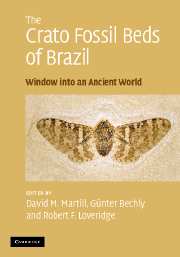Book contents
- Frontmatter
- Contents
- Contributors
- Preface
- Acknowledgements
- Part I The Crato Formation Konservat Lagerstätte
- 1 Introduction to the Crato Formation
- 2 The geology of the Crato Formation
- 3 Stratigraphy of the Crato Formation
- 4 The sedimentology and depositional environment of the Crato Formation
- 5 Commercial exploitation of the Crato Formation
- 6 Preparation techniques for Crato Formation fossils
- Part II The invertebrate fauna
- Part III The vertebrate fauna
- Part IV The flora
- Part V Miscellanea
- Appendix: species list for the Crato Formation
- Systematic index
- Plate section
- References
1 - Introduction to the Crato Formation
Published online by Cambridge University Press: 22 August 2009
- Frontmatter
- Contents
- Contributors
- Preface
- Acknowledgements
- Part I The Crato Formation Konservat Lagerstätte
- 1 Introduction to the Crato Formation
- 2 The geology of the Crato Formation
- 3 Stratigraphy of the Crato Formation
- 4 The sedimentology and depositional environment of the Crato Formation
- 5 Commercial exploitation of the Crato Formation
- 6 Preparation techniques for Crato Formation fossils
- Part II The invertebrate fauna
- Part III The vertebrate fauna
- Part IV The flora
- Part V Miscellanea
- Appendix: species list for the Crato Formation
- Systematic index
- Plate section
- References
Summary
The Crato Formation takes its name from the university town of Crato, Ceará, situated in a forested cirque in the north central part of the Chapada do Araripe, a large tableland in north-eastern Brazil (Plate 1a). Its outcrop pattern forms a narrow strip along the flanks of the plateau, and is also present as a few isolated outliers to the south of the plateau. As one of the few limestone units in the region, the Crato Formation supports a unique flora of lime-loving species, and even appears to have an endemic bird, the Araripe manakin, Antilophia bokermanni, living on the outcrop near Arajara. This bird was only discovered in 1996 (Coelho and Silva, 1998) and apparently has the smallest geographic range of any bird species, only 1 km2.
The Crato Formation is mined commercially for cement manufacture and paving stones, and is thus of considerable economic importance to the region, providing both raw materials and employment in its extraction (Plate 1b). It is in the quarries where the slabby limestones are extracted for paving stones that an astonishingly high number of rare and beautiful fossils occur. The preservation of the fossils is often exquisite, and many form the centre pieces of museum exhibitions. Although the formation is some 50–60 m thick, and comprises a varied series of rock types, it is only the basal unit, a 0–13-m-thick series of laminated limestones known as the Nova Olinda Member, that yields the spectacular fossils, and earns the formation its status as a Fossil Konservat Lagerstätte.
- Type
- Chapter
- Information
- The Crato Fossil Beds of BrazilWindow into an Ancient World, pp. 3 - 7Publisher: Cambridge University PressPrint publication year: 2007
References
- 4
- Cited by



